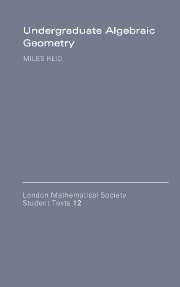Book contents
Summary
This final section is not for examination, but some of the topics may nevertheless be of interest to the student.
History and sociology of the modern subject.
(8.1) Introduction. Algebraic geometry has over the last thirty years or so enjoyed a position in math similar to that of math in the world at large, being respected and feared much more than understood. At the same time, the ‘service’ questions I am regularly asked by British colleagues or by Warwick graduate students are generally of an elementary kind: as a rule, they are either covered in this book or in [Atiyah and Macdonald]. What follows is a view of the recent development of the subject, attempting to explain this paradox. I make no pretence at objectivity.
(8.2) Prehistory. Algebraic geometry developed in the 19th century from several different sources. Firstly, the geometric tradition itself: projective geometry (and descriptive geometry, of great interest to the military at the time of Napoleon), the study of curves and surfaces for their own sake, configuration geometry; then complex function theory, the view of a compact Riemann surface as an algebraic curve, and the purely algebraic reconstruction of it from its function field. On top of this, the deep analogy between algebraic curves and the ring of integers of a number field, and the need for a language in algebra and geometry for invariant theory, which played an important role in the development of abstract algebra at the start of the 20th century.
Information
- Type
- Chapter
- Information
- Undergraduate Algebraic Geometry , pp. 114 - 128Publisher: Cambridge University PressPrint publication year: 1988
